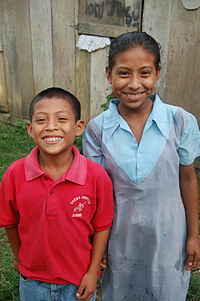Qʼeqchiʼ
Over the course of the succeeding centuries a series of land displacements, resettlements, persecutions and migrations resulted in a wider dispersal of Qʼeqchiʼ communities into other regions of Guatemala (Izabal, Petén, El Quiché), southern Belize (Toledo District), and smaller numbers in southern Mexico (Chiapas, Campeche).[4] While most notably present in northern Alta Verapaz and southern Petén,[5] contemporary Qʼeqchiʼ language-speakers are the most widely spread geographically of all Maya peoples in Guatemala.[7] Not much more is known about the lives and history of the Qʼeqchiʼ people prior to being conquered by Spanish conquistadors; however, it is known that they were a Maya group located in the central highlands and northern lowlands of Guatemala.[8] Traditionally the Qʼeqchiʼ people believe in the Tzuultaqʼa (a compound of tzuul "hill" and taq'a "valley"), male and female guardian deities which inhabit the local mountains.The QHA along with the Belize Indigenous Training Institute funded a project which would develop a traditional healing garden and culture center.Here the Qʼeqchiʼ Healers shared their similar methods that had been passed down to them in the hopes of preserving rare plant life and educating their community.They are preserving the biodiversity of their region by coming up with different options other than wild harvesting as well as was to propagate and cultivate many rare plant species.
Qʼeqchiʼ languageGuatemalaBelizeMexicoEl SalvadorHondurasQʼeqchiʼSpanishEnglishEvangelicalMennoniteMaya religionEastern OrthodoxOriental OrthodoxMaya peopleSpanish conquest of GuatemaladepartmentsAlta VerapazBaja VerapazIzabalPeténEl QuichéToledo DistrictChiapasCampecheBartolomé de las CasasDay of the DeadKaq'ikCristina CocEquator PrizeRodrigo TotGoldman Environment PrizeOscar SantisEthnologueThe Reporter (Belize)SIL InternationalUniversity of Texas PressNorthern Illinois University PressUniversity of Oklahoma PressGuatemalan citizensAkatekAwakatekChʼortiʼJakaltekKaqchikelKʼicheʼPoqomamPoqomchiʼQʼanjobʼalSakapultekSipakapenseTektitekTzʼutujilUspantekAcala ChʼolAlaguilacChinamitaKejacheLakandon ChʼolManche ChʼolTojolabalToqueguaYalainMestizoLadinoCriolloFrenchGermanItalianRussianJewishKoreanRomaniAfro-descendantsGarifunaMulattoAmericansMexicansSalvadoransIndigenous peoples of MexicoChinantecChʼolHuastecMazahuaMazatecMixtecPurépechaRarámuriTlapanecTotonacTzeltalTzotzilZapotecAmuzgoChatinoChontal MayaCuicatecPopolucaTepehuánTriquiWixarikaChichimeca JonazChochoGuarijioLacandonMatlatzincaMexicaneroOcuiltecPima BajoTacuateTepehuaChiricahuaCochimíCucapáIxcatecosKikapúKiliwaKumiaiLipánMezcaleroMotozintlecoPaipaiTohono OʼodhamWestern ApacheAncestry and ethnicity in BelizeManche Ch'ol